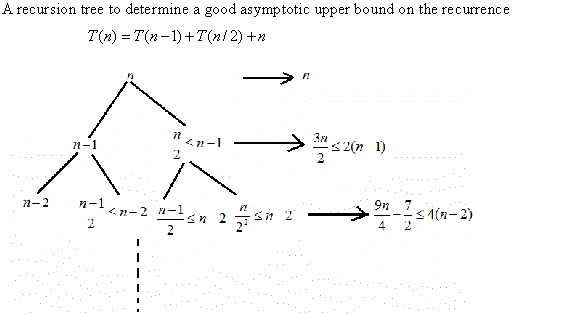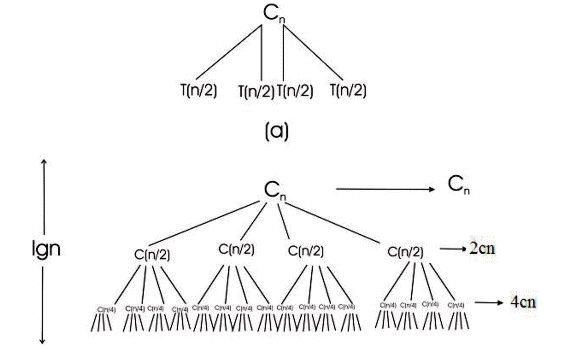Consider the given recurrence:

Now, user have to determine the asymptotic upper bound on this given relation using a recurrence tree. It is already known that, the floor and ceil value usually do not matter in solving recurrences.
Consider the following recurrence tree for the given
recurrence . Here, the
value of
. Here, the
value of  is assumed
exact power of 2 for convenience. It is chosen as exact power of 2
because all the sub-problems sizes became integer.
is assumed
exact power of 2 for convenience. It is chosen as exact power of 2
because all the sub-problems sizes became integer.
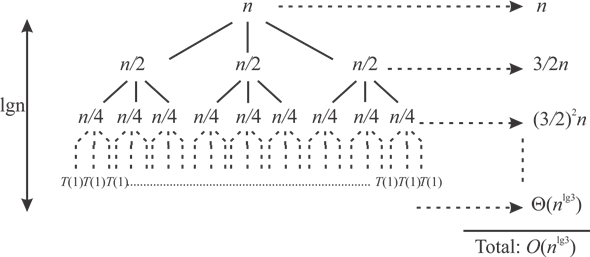
In the above recurrence tree,
• At each time when user go down one level, the subproblems
sizes decreases by a factor 2, user eventually must reach a
boundary condition  .
.
• To calculate the depth of the tree, user obtain the
sub-problem size for a node at depth i is  .
.
• Therefore, the sub-problem size hits  when
when
 or,
or,
 .
.
Hence, the tree has  levels.
levels.
Now, user have to determine the cost at each level of the tree.
At each level, the nodes increased 3 times as the node exists on
the above level. So the number of nodes at depth  is given
as
is given
as .
.
It has already known that, “at each time when user go down one
level, the subproblems sizes decreases by a factor 2”, so each node
at depth  , where
, where
 ,
has a cost of
,
has a cost of  .
.
Now, the total cost over all nodes at depth  , will be
obtain after taking the product of the number of nodes at depth
, will be
obtain after taking the product of the number of nodes at depth
 and
the cost of each node at the depth
and
the cost of each node at the depth  .
.
Therefore,

At the bottom level where the depth is equal to , the number
of nodes will be given as
, the number
of nodes will be given as , where the
contribution of the cost by each node is
, where the
contribution of the cost by each node is .
.
Therefore, the total contribution of the cost at bottom level
is ,
which is
,
which is  Here, it is
assumed that the value of
Here, it is
assumed that the value of  is
constant.
is
constant.
Now, user have to sum up the costs over each levels to determine the cost for the entire tree:

Now, use the Sigma to add all the elements except the last one.

Now, use the geometric series formula, then user will obtain:

Now, evaluate the fraction,

Hence, the asymptotic upper bound on this given recurrence
 is
given by
is
given by .
.
A recursion tree to determine a good asymptotic upper bound on the recurrence

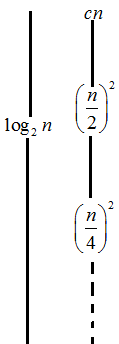
The costs over all levels to determine the cost for the entire tree:

Now, we can use the substitution method to verify that our guess
was correct, that is  is an upper
bound for the recurrence
is an upper
bound for the recurrence  .We want to
show that
.We want to
show that  for some
constant
for some
constant .
.



This condition holds when n>0 and d=4.
Hence, asymptotic of the upper bound on the recurrence
 is
verified.
is
verified.
• The recursion tree is used to calculate the time taken by any recursive algorithm for its recurrence relations.
• Recursion tree is the parse tree generated by using the recurrence relation.
• In the recursion tree method we first generate the tree for
the given recurrence relation and then calculate the complexity for
the base case that is  and then
from this user calculate the complexity for the n.
and then
from this user calculate the complexity for the n.
The general recurrence relation where  is the
number of sub-problems and
is the
number of sub-problems and  is the size
of each sub problem:
is the size
of each sub problem:
 …… (1)
…… (1)
Now consider the recurrence relation provided in the question.
 …… (2)
…… (2)
The recursion tree for the recurrence relation in the equation (2) is as follows:
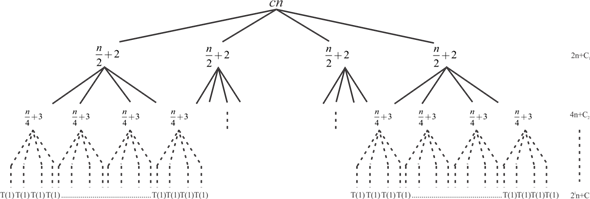
Here the tree is derived from the constant function n and
divides into 4 sub-problems each having size of .
.
• For the simplification of the problem, ignore the constant
term, that is, 2 in . The tree
extends to its trivial case
. The tree
extends to its trivial case .
.
• The sub-problem size of node at depth i is n/2i .Thus, the sub-problem size hits n=1 when n/2i =1.
Length of the tree will be given as
 or
or  …… (3)
…… (3)
Taking the log of equation (3)
So,

 (Since log 2 =1)
(Since log 2 =1)
Each level has 4 times more nodes than the previous above. So, the number of leaves at level i are 4i.
Now, put the value of i, then the number of leaves at level i will be given as:

Simplifying further,

Since at i = log n, T(n/2i) = T(1) , so each leaf in contributing cost T(1). Total cost is n2 since it is assumed that T(1) is constant.
Now the equation can be written as:

Taking out constant n, user can solve this expression by taking only the first value of i which is 0 because c(1/2i) is a decreasing geometric progression.
Now, ignoring the decreasing constants
 …… (4)
…… (4)
Since for upper bound, user can take the max of (n, n2). Hence, equation (4) shows a good asymptotic upper bound for the recurrence relation.
Now use substitution method to verify the solution of recurrence relation.

The upper bond of  of the
problem should be less than or equals to the terms at the right
hand side with
of the
problem should be less than or equals to the terms at the right
hand side with  as the outer
boundary
as the outer
boundary

So,

Hence recurrence tree method and the substitution method builds
up a complexity of
Recursion tree is a tree generated by calling the problem recursively. Each node in the rcursion tree reprsents the cost or time taken by a single sub problem. Recursion tree is used to find a good upper bound on a recurrsion. The total cost of the whole problem can be obatained by adding costs of all sub problems.
Finding upper bound on the  using recursion tree:
using recursion tree:
The given recurence is  …...(1)
…...(1)
Generate the recursion tree by calling T(n) recursively as follows:
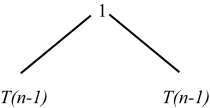
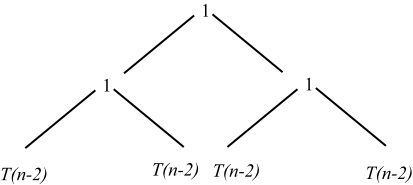
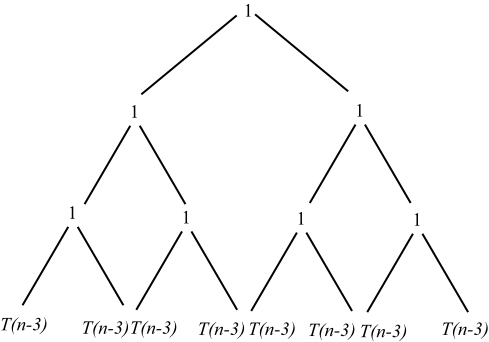
Further calling the problem recursively, the following fully expanded tree is obtained.
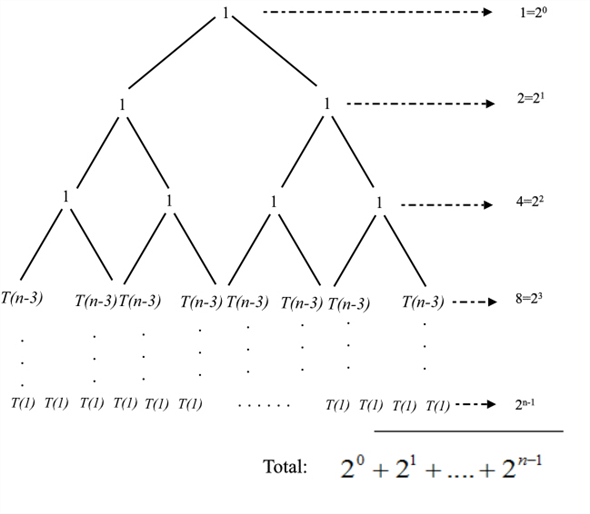
Now the total cost = 
=
= 
Therefore the  is
the uppder bound on the given reucrrence .
is
the uppder bound on the given reucrrence .
The above upper bound can be verified using the substitution method as follows:
In the substitution method a solution is gussed every time and checked wether it is working or not.
Assume that  is the
solution for the given recurrence.
is the
solution for the given recurrence.
Thus, it is requried to show  . Where the
constant
. Where the
constant 
Now substitute the result of the guess in the given recurrence.

 .
.
Now make a furtehr smaller guess, that is  , where the
constant
, where the
constant  .
.
Thus,
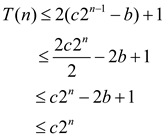
The abvoe condition is true for  .
.
Therefore it is verified that  is
the uppder bound on the given reucrrence .
is
the uppder bound on the given reucrrence .
Recursion tree for the recurrence relation is:
is:
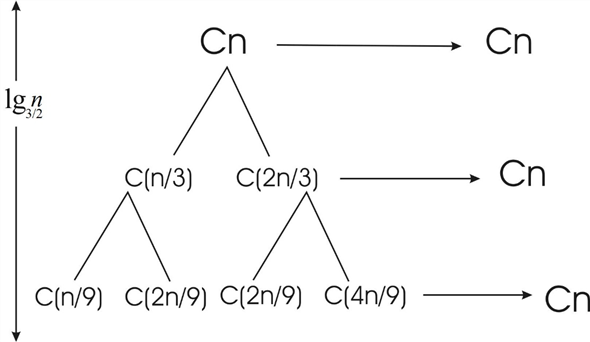
Total: O(nlogn)
The longest simple path from the root to a leaf is  since,
since,
 when
when  ,the height
of the tree is
,the height
of the tree is  ,the height
of the part of the tree in which every node has two children is
log3 n.
,the height
of the part of the tree in which every node has two children is
log3 n.
The cost at each level of the tree is exactly c*n. To find a lower bound on the cost of the algorithm, a lower bound is required on the height of the tree.
Since the values at each of these levels of the tree add up to
cn, the recurrence relation is at least 
The given recurrence is,  .
.
The recursion tree for given recurrence is,
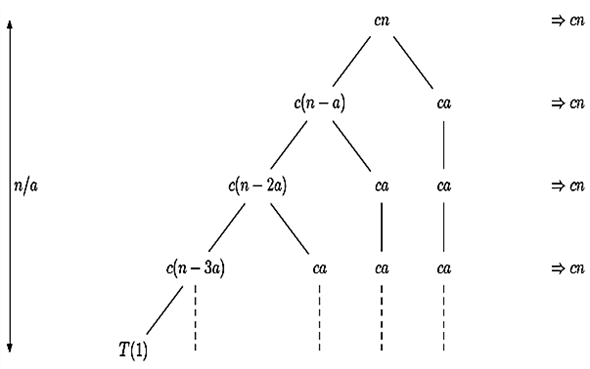
The cost at each level is the code of the node. There are
 levels in the tree. When the cost at each level is summed, the
total cost of the algorithm is:
levels in the tree. When the cost at each level is summed, the
total cost of the algorithm is:

Now assume that n is divisible by a and ignore the ceiling functions, so the asymptotic complexity becomes:

The given recurrence is  .
.
Let  so
that
so
that .
.
The recursion tree for given recurrence is,
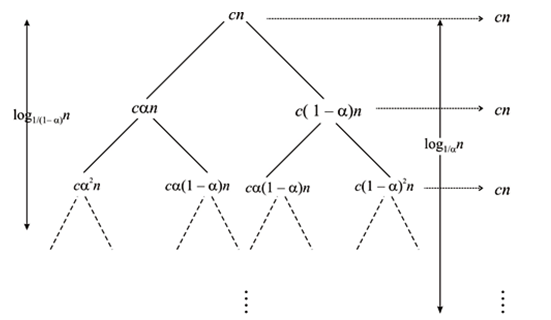
The recursion tree is full for , each
contributing cn. Therefore let the guess be
, each
contributing cn. Therefore let the guess be  .
.
It has  levels,
each contributing
levels,
each contributing . Therefore,
the guess is,
. Therefore,
the guess is, .
.
Show  by
substitution method as follows:
by
substitution method as follows:
To get the upper bound, show that  d
> 0.
d
> 0.

 .
.
This is same as .
.
As 
 .
.
Thus,  , so that
when multiplied, both sides of the inequality by this factor, the
inequality is to be reversed.
, so that
when multiplied, both sides of the inequality by this factor, the
inequality is to be reversed.

The fraction on the right – hand side is a positive constant, and so it suffices to pick any value of d that is greater than or equal to this fraction.
To prove lower bound, show that T (n)  for some
d>0.
for some
d>0.
The same proof as for the upper bound can be used by
substituting .
.
Thus,  .
.
Therefore,  .
.
